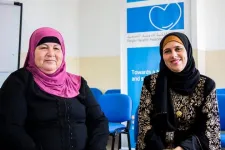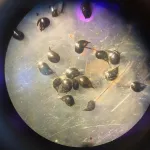New study suggests monetary reparations for Black descendants of people enslaved in the United States could have cut SARS-CoV-2 transmission and COVID-19 rates both among Black individuals and the population at large.
Researchers modeled the impact of structural racism on viral transmission and disease impact in the state of Louisiana. The higher burden of SARS-CoV-2 infection among Black people also amplified the virus's spread in the wider population.
Reparations could have reduced SARS-CoV-2 transmission in the overall population by as much as 68 percent.
Compared with white people, Black individuals in the United States are more likely to be infected with SARS-CoV-2, more likely to end up in the hospital with COVID-19, and more likely to die from the disease.
Civil rights activists have long called for monetary reparations to the Black descendants of Africans enslaved in the United States as a financial, moral, and ethical form of restitution for the injustices of slavery.
Now, a study led by Harvard Medical School researchers suggests reparations could also have surprising public health benefits for Black individuals and the entire nation.
To estimate the impact of structural inequities between Black and white individuals, the researchers set out to capture the effect of reparation payments on the Black-white wealth gap in the state of Louisiana.
Their analysis, published online on Feb. 9 in Social Science & Medicine, suggests that if reparations had been made before the COVID-19 pandemic, transmission of SARS-CoV-2 in the state's overall population could have been reduced by anywhere from 31 percent to 68 percent.
The work was done in collaboration with the Lancet Commission on Reparations and Redistributive Justice.
"While there are compelling moral and historical arguments for racial-injustice interventions such as reparations, our study demonstrates that repairing the damage caused by the legacy of slavery and Jim Crow racism would have enormous benefits to the entire population of the United States," said study senior author Eugene Richardson, assistant professor of global health and social medicine in the Blavatnik Institute at Harvard Medical School.
The disproportionate effects of COVID-19 on racial minorities--Black individuals in particular--have been well documented. Black people get COVID-19 at a rate nearly one and a half times higher than that of white people, are hospitalized at a rate nearly four times higher, and are three times as likely to die from the disease, according to the latest estimates from the U.S. Centers for Disease Control.
The greater disease burden among Black people has caused tremendous loss of life and unspeakable suffering across these already vulnerable and disadvantaged communities. Notably, these effects have also spilled over and are driving transmission rates of the virus in the overall population, the study authors said.
Addressing the structural inequalities at the roots of this disparity through monetary reparations would not only radically decrease the impact of COVID-19 among the people who received reparations, the authors said, but would reduce the overall toll of the disease on a broader scale, benefiting the entire population.
The findings, the researchers said, powerfully underscores the truly global nature of the pandemic and the notion that a society is only as strong as its most vulnerable members.
"If we extrapolate these results to the entire United States, we can imagine that tens or hundreds of thousands of lives would have been spared, and the entire nation would have been saved much of the hardship it has endured in the last year," said Richardson, who is also the chair of the Lancet Commission on Reparations and Redistributive Justice.
For their analysis, the researchers paired sophisticated data analytics and computational tools with commonly used epidemiologic modeling methods to calculate the impact of structural racism on infection rates among Black and white populations in Louisiana. They chose Louisiana as an exemplar of the impacts of structural racism in the U.S. because it was one of the few states that reported infection rates by race in the early stages of the pandemic. For a control group, the researchers chose the relatively egalitarian population of South Korea.
The researchers noted that although modeling is used to understand many factors in the spread of an infectious disease, such as differences in infection risk based on whether passengers on a train sit with windows open or closed or individual variations in mask-wearing habits, it has rarely been used to capture the effects of social factors that can create vast disparities between populations, such as those seen between Blacks and whites in the U.S.
Richardson's recent book Epidemic Illusions explores the ways conventional epidemiology is constrained from proposing solutions that address the root causes of health disparities derived from the combined weight of centuries of racism, imperialism, neoliberal politics, and economic exploitation. One of the goals of the paper is to challenge the narrow ways people who work in medicine and public health measure and think about problems and solutions and to broaden the public imagination, thus opening new conversations about what challenges and opportunities are worth considering in global health and social science, Richardson said.
The study examined the initial period of the outbreak, before infection control measures were implemented, so any differences in infection rates between populations at that time would have been driven mainly by differences in the social structures, the researchers said.
For example, Louisiana has a population heavily segregated by race, with Black people having higher levels of overcrowded housing and working jobs that are more likely to expose them to SARS-CoV-2 than white people. In comparison, South Korea has a more homogenous population with far less segregation.
To probe how such structural inequities impact transmission of SARS-CoV-2, the researchers examined infection rates over time for the first two months of the epidemic in each location. During the initial phase of the outbreak in Louisiana, each infected person spread the virus to1.3 to 2.5 more people than an infected individual during the same phase of the outbreak in South Korea, the analysis showed. The study also showed it took Louisiana more than twice as long to bring the early wave of the epidemic under control as South Korea.
Next, the researchers used next-generation matrices to gauge how overcrowding, segregation, and the wealth gap between Blacks and whites in Louisiana could have driven higher infection rates and how monetary reparations would affect viral transmission.
The model showed that greater equity between Blacks and whites might have reduced infection transmission rates by anywhere from 31 percent to 68 percent for every person in the state.
This research comes at a time when many Americans are already thinking about the larger societal costs of structural racism, the researchers said. They noted, for example, that the nationwide movement to protest police brutality against Black people has been fueled by many of the inequitable outcomes exemplified so painfully by the coronavirus pandemic in the U.S.
"This moment has made it possible for a lot of people who had no reason to think about these inequalities to be very aware of them," said study co-author and Lancet reparations commissioner Kirsten Mullen, who was a member of concept development team for the National Museum of African American History and Culture.
Anti-racism in action
Richardson said that the research was designed to explore how reparations payments might have altered the trajectory of the coronavirus pandemic in the U.S. and how a different response to the disease could have helped mitigate the disparities fueled by social conditions that are vestiges of slavery. Such conditions, Richardson noted, include ongoing discrimination and structural racism in the form of redlining, overcrowding, over-incarceration, and the heightened use of lethal force in policing experienced by Black people.
Richardson said that historian and anti-racist scholar Ibram X. Kendi's description of the differences between racism and anti-racism were helpful in designing the study. According to Kendi, a racist policy is any policy that produces or sustains inequality or promotes the power of one racial group over another, whereas an anti-racist policy is any measure that produces or sustains equity between racial groups.
Richardson said that one important goal of the project was to attempt to harness the power of mathematical modeling for an anti-racist response to the coronavirus and beyond.
"When you look at a formula for transmissibility, it looks like an objective calculation," he said. "But where is lethal policing in that formula?"
Richardson noted that it was important to call attention to the systemic and structural elements of racism that can get lost in simplified models of disease.
What are reparations?
Mullen and study co-author William Darity, who recently published a book on reparations and have written in the press about the case for using reparation payments to fight COVID-19, defined reparations as a program of acknowledgement, redress, and closure for a grievous injustice. In this case, Mullen said, the atrocities are associated with periods of enslavement, legal segregation and white terrorism during the Jim Crow era, and racial strife and violence of the post-Civil Rights Act era, including ongoing inequities in the form of over-policing, police executions of unarmed Black people, ongoing discrimination in regard to incarceration, access to housing, and, possibly most important, the Black-white gulf in wealth.
Successful reparations programs include three elements: admission of culpability on behalf of the perpetrators of the atrocity; redress, in the form of an act of restitution; and closure, wherein the victims agree that the debt is paid and no further claims are to be made unless new harms are inflicted.
In this case, Mullen said, reparations would take the form of financial restitution for living Black individuals who can show that they are descended from at least one ancestor who was enslaved in the U.S. and that they self-identified as Black on a legal document at some point during the 12 years prior.
The financial restitution is designed to help close the Black-white wealth gap. Darity noted that it is important to distinguish wealth from income. Wealth is how much you own, and income is how much you earn. Greater wealth translates to greater stability for individuals and families across time. Greater wealth is also more strongly associated with greater well-being than greater income, Darity said, and disparities in wealth manifest as health disparities.
"Wealth is more strongly associated with familial or individual well-being," said Darity, who is the Samuel DuBois Cook Distinguished Professor of Public Policy at Duke University and a Lancet reparations commissioner. He noted that, according to the Federal Reserve Board 2016 Survey of Consumer Finances, the average Black household had a net worth $800,000 lower than the average white household, and that Black people, who represent 13 percent of the U.S. population, only own 3 percent of the nation's wealth.
"This dramatically restricts the ability of Black Americans to survive and thrive," Darity said.
To assess the effect of reparation payments on the trajectory of the pandemic, the researchers based their calculations on a model that would pay $250,000 per person or $800,000 per household to descendants of enslaved individuals--one of several proposed reparation models.
Every transmission is a social transmission
"Every transmission has a social cause," said study co-author and Lancet reparations commissioner James Jones, associate professor of Earth System Science and a senior fellow at the Woods Institute for the Environment at Stanford University.
For a brief moment when AIDS was in the spotlight during the late 80s and early 90s, people interested in social behavior became interested in mathematical modeling of disease, Jones said. While that interest largely waned, the COVID-19 crisis has highlighted the need to think about social science, inequality, social structure, behavior patterns, and behavior change, as well as how they fit together with how we understand and respond to epidemics, Jones said.
Even the simplest model must account for a rudimentary social structure, Jones said. At its most basic, this can be represented with a generalized estimate of how likely an infected person is to come into contact with a susceptible person. He explained that this number, R0 or "R-naught," is the average number of people an infected individual transmits the virus to. When R0 is less than one, no epidemic is possible because the number of people infected decreases. When R0 is greater than 1 an epidemic is possible. R0 also determines the total number of people who could potentially become infected or how many people would need to be vaccinated to end the epidemic. It can also be used to calculate the so-called endemic equilibrium--which determines whether a disease will continue to exist within a population, simmering constantly in the background or bubbling up seasonally, like influenza.
"That's the theory of infectious disease control in a single parameter," Jones said.
That seeming simplicity can make it hard to focus on the complex ways that infectious diseases move through the real world, the researchers said.
"It's important to highlight that R0 is not simply a function of the pathogen," Jones said. "It's a function of the society." Social and environmental factors like mobility, segregation, and the nature of the built environment help determine rates of infection, he said.
This is one important reason that diseases don't hit all people the same. Global R0 is an average of very different R0s for different groups of people. Some groups are more likely to interact only with members of their own group, some groups are more likely to come in contact with infected people, and some are more susceptible to the disease for other reasons, Jones said.
In this case, the researchers used mathematical models to help understand the differences in R0 for Black people and white people in Louisiana and to help think about how things would change if racism were less prevalent in America.
Absent those interventions, the researchers noted that Black Americans remain at an elevated and inequitable risk of becoming infected and dying during the COVID-19 pandemic and that this inequity will continue to fuel the pandemic for all Americans.
"Increasing equality would have huge benefits on infection rates for everyone," said co-author Momin Malik, who was a data science postdoctoral fellow at the Berkman Klein Center for Internet & Society at Harvard University at the time the study was conducted.
INFORMATION:
This research was supported by the National Institute of General Medical Sciences Models of Infectious Disease Agent Study (grant R01 GM130900), National Institute of Allergy and Infectious Diseases (grant K08 AI139361), National Institute of Minority Health Disparities (grant R01 MD011606), National Science Foundation Division of Social and Economic Sciences (grant 1851845), Institute of Education Sciences (grant R305A190484), and the Ethics and Governance of Artificial Intelligence Fund.
Release written by Jake Miller
About Harvard Medical School
Harvard Medical School has more than 11,000 faculty working in the 11 basic and social science departments comprising the Blavatnik Institute and at the 15 Harvard-affiliated teaching hospitals and research institutes: Beth Israel Deaconess Medical Center, Boston Children's Hospital, Brigham and Women's Hospital, Cambridge Health Alliance, Dana-Farber Cancer Institute, Harvard Pilgrim Health Care Institute, Hebrew SeniorLife, Joslin Diabetes Center, Judge Baker Children's Center, Massachusetts Eye and Ear/Schepens Eye Research Institute, Massachusetts General Hospital, McLean Hospital, Mount Auburn Hospital, Spaulding Rehabilitation Network and VA Boston Healthcare System.




